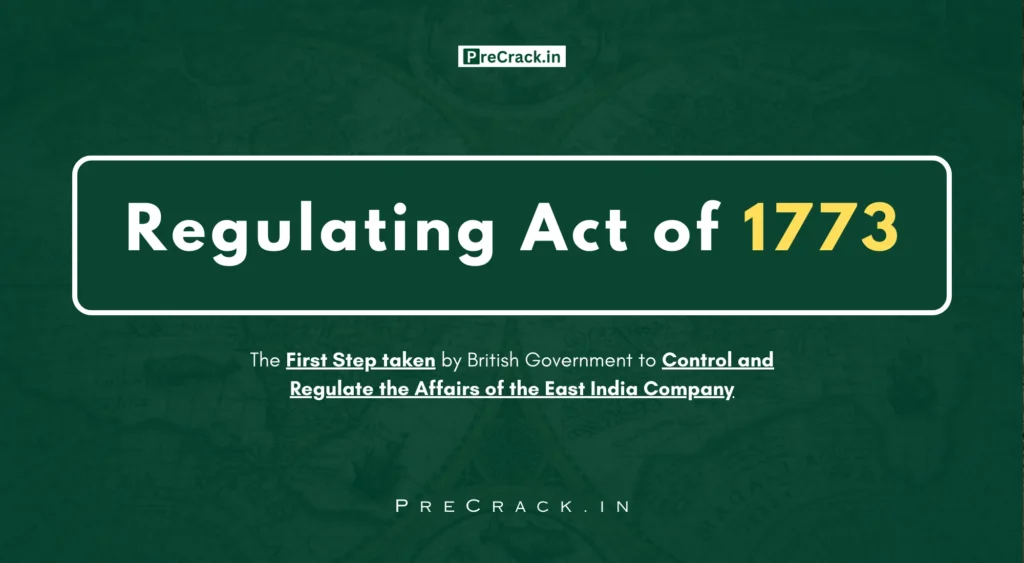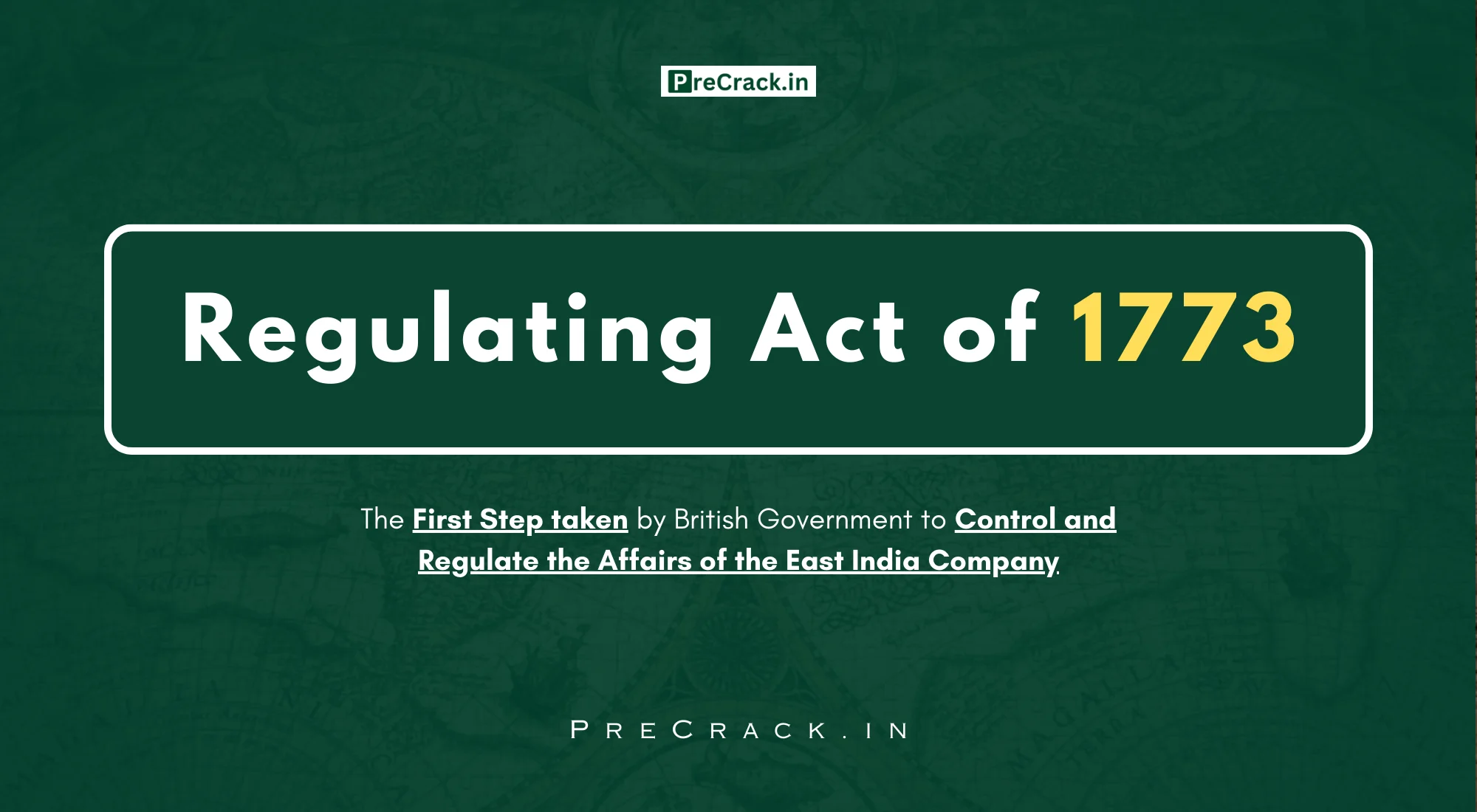Welcome to PreCrack! We’re here to provide you Information about all best topics in their simplest manner that may help you to Crack UPSC CS Prelims Exam.
Naresh Soni
What is the Regulating Act of 1773? – History of Indian Constitution – PreCrack.in
Table of Contents
Introduction to the Regulating Act of 1773 UPSC
Welcome to PreCrack! In India, If you are preparing for Civil Service Examinations, then knowing about history of Indian constitution or the background of Indian constitution is important. In this context, the Regulating Act of 1773 is also a crucial part of the history of Indian Constitution.
If you want to know the precise details about Regulating Act of 1773 and complete details about it, then in this blog, we have added all the details about Regulating Act of 1773 precisely.
So, let’s start-

Read Also | Full List of All Salient Features of Indian Constitution Explained!
What is the Regulating Act of 1773?
The Regulating Act of 1773 was an important legislation made by the British Parliamen. It was the first attempt to regulate the East India Company’s activities in India. It established the office of the Governor-General of Bengal, with Warren Hastings being the first appointee.
The Act created an Executive Council to aid the Governor-General and subordinated the governors of Bombay and Madras to the Governor-General. Additionally, it established a Supreme Court in Calcutta and imposed regulations on Company servants to prevent corruption. This Act laid the foundation for centralized British control over India’s political and administrative affairs during the colonial period.
Source – Wikipedia / Lakshmikant
Objective / Purpose
We have added the objectives of this act named Regulating Act 1773 Below-
- Establish control: The Act aimed to establish British government control over the East India Company’s activities in India.
- Centralize authority: It sought to centralize administrative authority by creating the position of Governor-General of Bengal.
- Streamline governance: The Act aimed to streamline governance by making the governors of Bombay and Madras presidencies subordinate to the Governor-General.
- Judicial reform: It introduced judicial reforms by establishing the Supreme Court at Calcutta to administer justice.
- Prevent corruption: Regulations were imposed to prevent Company servants from engaging in private trade and accepting bribes.
- Enhance oversight: The Act aimed to enhance British government oversight by requiring regular reporting on Company affairs.
- Improve administration: Its purpose included improving the overall administration of British territories in India.
- Lay foundation for future reforms: It laid the foundation for future administrative and constitutional reforms in India.
- Assert British authority: The Act was intended to assert British authority over Indian territories.
- Address administrative chaos: It sought to address the administrative chaos that followed the Company’s growing influence in India after the Battle of Plassey.
Features
The features of the Regulating Act of 1773 include
- Governor-General of Bengal: Designated the Governor of Bengal as the Governor-General of Bengal, establishing a centralized authority figure.
- Executive Council: Created an Executive Council of four members to assist the Governor-General in administration.
- Subordination of Presidencies: Made the governors of Bombay and Madras presidencies subordinate to the Governor-General of Bengal.
- Establishment of Supreme Court: Introduced the establishment of a Supreme Court at Calcutta comprising one chief justice and three other judges to administer justice.
- Regulation of Company Servants: Imposed regulations on East India Company servants, prohibiting them from engaging in private trade and accepting bribes.
- Increased British Government Control: Strengthened British government control over the Company by requiring regular reporting on revenue, civil, and military affairs in India.
Key Provisions of Regulating Act 1773
Key provisions of the Regulating Act of 1773 include:
1. Governor of Bengal
The Act established the office of the Governor-General of Bengal, who was to be appointed by the Crown. Warren Hastings was the first person to hold this position.
2. Governor-General’s Council
It created the Governor-General’s Council consisting of four members, including the Governor-General. This council was tasked with making important decisions regarding the governance of British territories in India.
3. Dual Control
The Act introduced a system of dual control, whereby the British government exercised some oversight over the East India Company’s activities in India. This marked the beginning of the British government’s increasing involvement in Indian affairs.
4. Supreme Court
The Act established a Supreme Court in Calcutta (now Kolkata) to administer justice and regulate the Company’s activities.
5. Provincial Councils
It allowed the formation of provincial councils in Bombay and Madras, although these councils had limited powers compared to the Governor-General’s Council in Calcutta.
The Regulating Act of 1773 laid the foundation for subsequent British administrative reforms in India and marked the beginning of formal British intervention in Indian governance. It was followed by several other Acts that further shaped British rule in India, ultimately leading to the Government of India Act 1858 and the direct rule of India by the British Crown.
What was the Need of Regulating Act 1773?
The Regulating Act of 1773 arose from several pressing needs for the British government:
1. Curbing Corruption and Misrule
The East India Company’s officials in Bengal were notorious for exploiting their positions for personal gain. This included private trade for their own benefit, often using their influence to manipulate markets, and accepting bribes from Indian rulers. This rampant corruption was enriching company officials at the expense of the Bengal treasury, leading to financial instability.
2. Financial Crisis
The Bengal Famine of 1770-73 further exacerbated the financial woes of the East India Company. The famine’s devastation and the company’s exploitative policies towards peasants severely reduced tax revenue. Additionally, the company’s focus on private trade pursuits diverted resources from proper administration. All this led to the company seeking a government loan, which brought its financial mismanagement under intense parliamentary scrutiny.
3. Loss of Control
The Company’s growing military power in India, particularly in Bengal, worried the British government. The fear was that the company, primarily focused on profit, might use its military for private gain or even threaten British interests. The government desired a way to exert control over the company’s military activities.
4. Public Outcry
News of the Bengal Famine and reports of corruption by company officials sparked public outrage in Britain. The Parliament felt pressured to address these issues and demonstrate some control over the company’s activities in India.
The Regulating Act was an attempt by the British government to address these needs. It aimed to bring accountability to the company’s governance, improve financial management, and establish some degree of central control over the company’s activities in India.
UPSC Questions on the Regulating Act of 1773
Question-1: What is the Regulating Act of 1773?
Answer. The Regulating Act of 1773 was an act passed by the British Parliament to regulate the affairs of the East India Company in India.
Question-2: What were the objectives of the Regulating Act of 1773?
Answer. The objectives of the Regulating Act of 1773 were to establish British government control over the East India Company, centralize administrative authority, reform the judicial system, prevent corruption among Company servants, and enhance oversight of Company affairs in India.
Question-3: How did the Regulating Act of 1773 impact India?
Answer. The Regulating Act of 1773 impacted India by introducing significant administrative and judicial reforms, centralizing British control over Indian territories, and laying the foundation for future constitutional developments in colonial India.
Question-4: Why is knowing about the Regulating Act of 1773 crucial for UPSC?
Answer. Knowing about the Regulating Act of 1773 is crucial for UPSC because it is a significant milestone in Indian constitutional history, and questions related to its provisions, impact, and historical context often appear in UPSC examinations.
Question-5: What were the key provisions of the Regulating Act of 1773?
Answer. The key provisions of the Regulating Act of 1773 include the designation of the Governor of Bengal as the Governor-General, creation of an Executive Council, establishment of a Supreme Court at Calcutta, regulations on Company servants, and increased British government control over the Company.
Question-6: Who was the First Governor-General of Bengal?
Answer. The first Governor-General of Bengal under the Regulating Act of 1773 was Warren Hastings.
Question-7: Who was the First Governor-General of India?
Answer. Warren Hastings was also the first Governor-General of India, as the title was later expanded to cover the entire Indian subcontinent.
Question-8: What were the features of the Regulating Act of 1773?
Answer. The features of the Regulating Act of 1773 included the establishment of the Governor-General of Bengal, creation of an Executive Council, subordination of Bombay and Madras presidencies, establishment of the Supreme Court at Calcutta, regulations on Company servants, and increased British government control over the Company.
Question-9: Who passed the Regulating Act of 1773?
Answer. The Regulating Act of 1773 was passed by the British Parliament.
Question-10: What was the Battle of Plassey?
Answer. The Battle of Plassey, fought in 1757, was a significant battle in Indian history where the British East India Company, under Robert Clive, defeated the Nawab of Bengal, Siraj-ud-Daulah, establishing British dominance in Bengal.
Question-11: How many members were there in the Governor-General’s council?
Answer. The Governor-General’s council established by the Regulating Act of 1773 consisted of four members, including the Governor-General.
Question-12: What was the dual control system in the Regulating Act of 1773?
Answer. The dual control system in the Regulating Act of 1773 involved the British government exercising some oversight over the East India Company’s activities in India, alongside the Company’s own management.
Question-13: Why was the Supreme Court established under the Regulating Act of 1773?
Answer. The Supreme Court was established under the Regulating Act of 1773 to administer justice and regulate the Company’s activities in India, providing a judicial mechanism for dispute resolution and upholding the rule of law.




2 thoughts on “What is the Regulating Act of 1773? – Top 10 UPSC Questions – PreCrack.in”
Comments are closed.